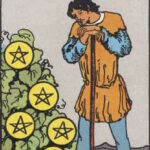In the intricate tapestry of symbolism woven through tarot, the dragon stands as a remarkably potent icon. Its multifaceted essence reflects the enigmatic duality of nature, suggesting both peril and protection, creation and destruction. When viewed through a Christian lens, the dragon’s representation bears profound nuance, compelling us to explore deeper spiritual themes and universal truths.
The dragon, often perceived as a fearsome beast in various mythologies, is sometimes portrayed as a manifestation of temptation and sin. In the Christian tradition, the dragon is frequently linked with the devil or the forces of evil that ignite discord and chaos. The Book of Revelation famously depicts a great red dragon, embodying the ultimate antagonist in the battle between good and evil. This allegorical figure serves as a reminder of the persistent struggle humanity faces against sinfulness and moral corruption, providing a cautionary narrative about the seductive allure of darkness.
Yet, the lens of tarot invites us to delve deeper. In the realm of tarot, the dragon may symbolize not only temptation but allegorical journeys and metamorphosis. When drawn in a reading, the dragon card could serve as a harbinger of transformative power, suggesting that one must confront their inner demons to attain spiritual enlightenment. This is reminiscent of the Christian notion of struggle—the trials and tribulations that forge resilience and deepen one’s faith. The dragon transcends its role as mere adversary; it is also a teacher, revealing the significance of facing one’s shadows to find redemption.
In Christian spirituality, the dragon can also reflect the dichotomy of creation and destruction. The dragon, akin to the biblical Leviathan, has the power to wreak havoc but is also a symbol of the primal forces of nature. Consider the concept of the dragon sleeping beneath the earth, representing both the raw potential for destruction and the fertile ground from which new life arises. This duality resonates with the Christian belief in death and resurrection—wherein the ‘death’ of old ways often heralds the ‘rebirth’ of the soul through grace.
Moreover, as one navigates the representational landscape of the dragon within the tarot, it is fascinating to contemplate the creature’s affiliations with guardianship and wisdom. In various cultures, dragons are revered as wise sages or protectors of sacred treasures. This aspect aligns with the Christian understanding of divine guardianship; the dragon becomes a metaphor for God’s protective presence in times of crisis. As believers are encouraged to seek refuge in their faith, so too can they recognize the dragon as a protectorate against the trials that beset them.
The dragon’s fiery breath, a quintessential feature in many tales, could also resonate with the Christian idea of the Holy Spirit—the divine fire that illuminates and purifies. This metaphorical connection underscores the transformative work of the Holy Spirit in the believer’s heart, igniting a fervor for faith and enlightenment. Just as the dragon’s flames can be destructive, they also serve a vital role in refining and purifying precious metals. Similarly, the spiritual fire offered by the Holy Spirit catalyzes a believer’s growth, often birthed through trials that challenge their faith.
Furthermore, the dragon in tarot evokes the theme of sovereignty and commanding presence. The desire to master one’s fears, represented by the dragon, mirrors a Christian’s journey towards spiritual sovereignty over sin. The act of confronting the dragon becomes a rite of passage—a necessary ordeal that leads not merely to survival but to mastery. In scripture, such quests demand not only courage but also unwavering faith in God’s purpose and promises. The dragon indeed becomes a symbol of the trials Christians must face, suggesting that true freedom is found in the strength of conviction and reliance on divine support.
This intriguing interplay of meanings brings forth another layer of significance. In tarot, the dragon may indicate stagnation or the need to confront certain truths that have long been ignored. This parallels St. Paul’s exhortations to scrutinize oneself, encouraging believers to root out sin and misunderstanding that obstruct their spiritual journey. The card’s appearance beckons introspection, prompting a believer to assess where they may allow the ‘dragon’ of doubt or disobedience to reign unchecked.
In conclusion, the dragon tarot card embodies a rich metaphorical tapestry when analyzed through a Christian perspective. It challenges believers to view their struggles not solely as obstacles but as essential components of their spiritual expedition. The juxtaposition of the dragon’s fearsome visage juxtaposed against its protective and transformative qualities serves as a reminder of the multifaceted nature of faith and the divine. The journey through the dragon, laden with temptation and trials, ultimately leads to enlightenment and liberation—an endeavor firmly rooted in the essence of Christian doctrine. Therefore, engaging with the dragon becomes a spiritual pilgrimage that wields the potential for profound revelation and understanding of one’s place within the divine narrative.









Leave a Comment